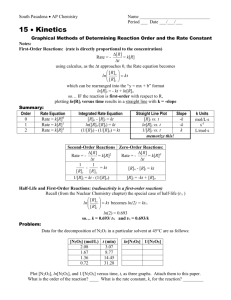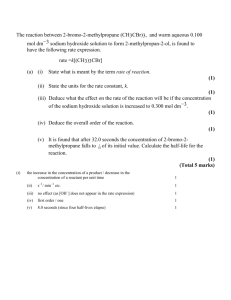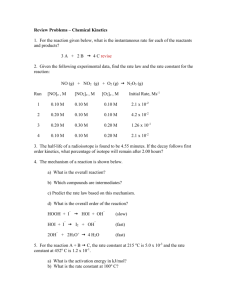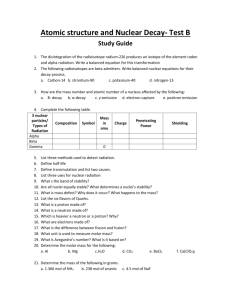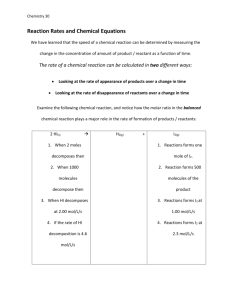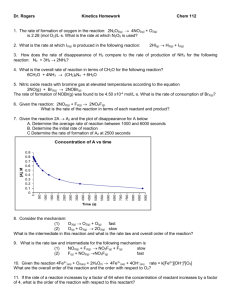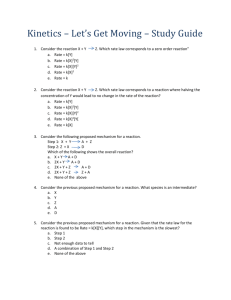112 ex iv lec outline f 04
advertisement
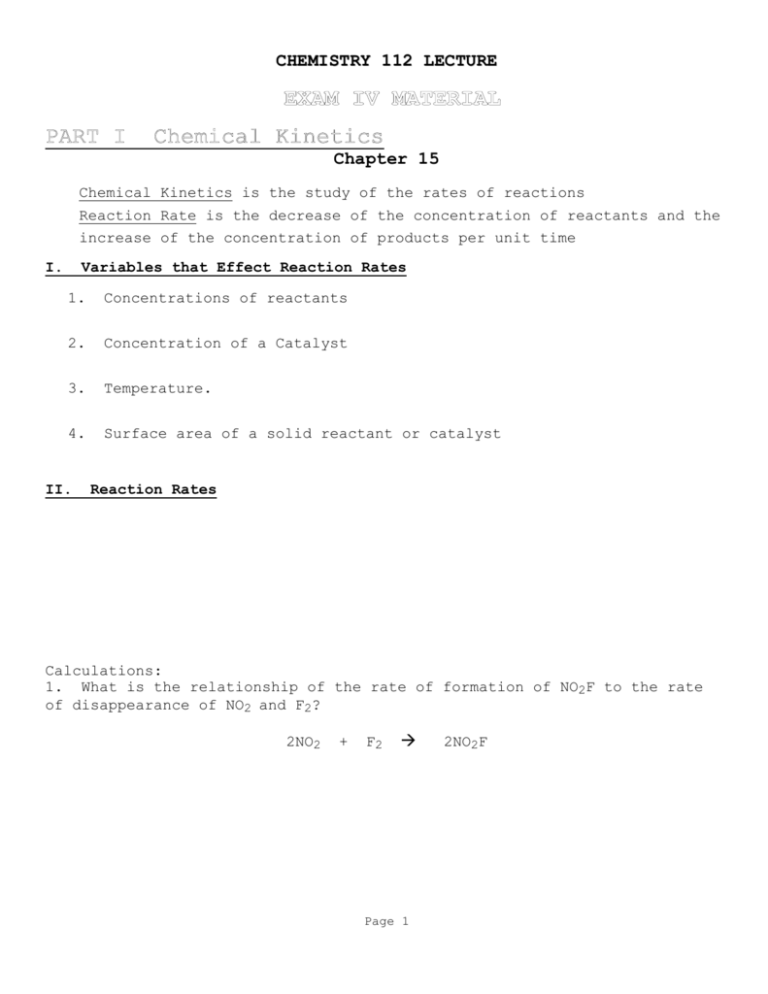
CHEMISTRY 112 LECTURE Chapter 15 Chemical Kinetics is the study of the rates of reactions Reaction Rate is the decrease of the concentration of reactants and the increase of the concentration of products per unit time I. Variables that Effect Reaction Rates 1. Concentrations of reactants 2. Concentration of a Catalyst 3. Temperature. 4. Surface area of a solid reactant or catalyst II. Reaction Rates Calculations: 1. What is the relationship of the rate of formation of NO2F to the rate of disappearance of NO2 and F2? 2NO2 + F2 Page 1 2NO2F Rates of reaction continued: 2. Calculate the average rate of N2O5 decomposition by the following reaction: 2N2O5(g) III. 4NO2(g) Time [N2O5] 600 s 1.24 x -2 M 1200 s 0.93 x 10-2 M + O2(g) Rate Law and Reaction Order Rate Law The Rate Law is an equation that equate the rate of a reaction to the concentration of the reactants: Chemical Eqn.: aA + bB + cC dD + eE Rate of Rxn = k [A]x [B]y [C]z Page 2 Reaction Order The Order of a particular species in a rate law is the exponent that the concentration of the species is raised to. The Reaction Order is the sum of all the exponents a rate law. 1. 2 N2O5 ---> 4 NO2 + O2 Rate = k[N2O5] 2. 2 NO + Cl2 ---> 2 NOCl Rate = k[NO]2 [Cl2] 3. 2 NH3 ---> N2 + 3 H2 + 6 H+ Rate = k[NH3]0 4. BrO3- + 5 Br- ---> 3 Br 2 + Rate = k[BrO3-] [Br-] [H+]2 Page 3 3 H2O Determination of Reaction Order and Rate Constant from Experimental Data: The Relationship between the rate and concentration of reactant must be determined experimentally: Determine the Reaction Order and Rate Constants for the following: 1. 2N2O5 ---> 4NO2 + O2 Experiment 1 2 2. H2O2 + 3 I- + 2 H+ Experiment 1 2 3 4 [H2O2] 0.010 0.020 0.010 0.010 Initial Conc. [N2O5] 0.010 0.020 ---> I3- + 2 H2O Initial Conc. [I-] 0.010 0.010 0.020 0.010 Page 4 Initial Rate [mol/L sec] 4.8 x 10-6 9.6 x 10-6 [H+] 0.00050 0.00050 0.00050 0.0010 Initial [mol/L 1.15 x 2.30 x 2.30 x 1.15 x Rate sec] 10-6 10-6 10-6 10-6 3. 2 NO + O2 ---> Experiment 1 2 3 4 5 2 NO2 Initial Conc. [NO] 0.020 0.020 0.020 0.040 0.010 Page 5 [O2] 0.010 0.020 0.040 0.020 0.020 Initial Rate [mol/L sec] 0.028 0.057 0.114 0.227 0.014 IV. Concentration-Time Equations - The Integrated Rate Law: First Order Rate Law 2 N2O5 ---> 4 NO2 + O2 The Rate Law is: The graph: Using calculus the following equation is derived: Graphing ln [A]t vs time: Problem: The decomposition of N2O5is first order with a rate constant of 4.80 x 10-4 /sec at 45°C. a. If the initial Molarity of N2O5 is 1.65 x 10-2 mol/L, what is the concentration at 825 s? b. At what time would the N2O5 concentration be 1.00 x 10-2 mol/L ? Page 6 Second Order Rate Law 2 NO2 ---> 2 NO + O2 The Rate Law is: The graph: Using calculus the following equation is derived: 1 Graphing [A] t vs time: Problem: The decomposition of NO2 is second order with a rate constant of 0.775 L/mol.s at 330°C. If the initial Molarity of N2O5 is 0.0030 mol/L, what is the concentration at 645 s? Page 7 Half - Life of a Reaction The half-life of a reaction is when the reactant concentration has decreased by 1/2 of its original concentration: Example: 1.0 M “A” t1/2 = Problem: 0.693 k for a first order rxn What is the half-life for N2O5 if k = 4.80 x 10-4/s, a first order reaction. V. The Effect of Temperature on the Rate Constant Svante Arrhenius in 1889 found that for most reactions, the rate of reaction increased with increasing temperature and that it is nonlinear. He found that most reactions obeyed the following equation: k = Ae-Ea/RT Where: k = Rate Constant A = The Frequency Factor related to the orientation and probability of collisions. Ea = Energy of Activation R = 8.31 J/mol-K Page 8 Problem: Using the information from the following table, for the reaction of methyl isonitrile at various temperatures: a. Calculate the Ea for the reaction b. Calculate the rate constant at 430.0 K Temperature, °C 189.7 230.3 VI. k,(s-1) . -5 2.52 x 10 6.30 x 10-4 Transition-State Theory Page 9 Page 10 VI. Reaction Mechanisms A Reaction Mechanism is the sequence of sequence of the bond-making and bond-breaking process which results in a reaction taking place: Rate Determining Step The rate of the overall reaction is limited by the slowest elementary step. The slowest elementary step is called the rate determining step (RDS) or the rate limiting step. Example 1 Slow Step: NO2 Fast Step: Example 2 Slow Step: Fast Step: + F2 F + NO2 NO2 + O3 NO2 + NO3 ---> NO2F + F ---> NO2F ---> NO3 + O2 ---> N2O5 Page 11 Rate Determining Step, cont’d Fast Step: NH3 + OCl- Slow Step: NH2Cl + NH3 Fast Step: N2H5+ + OH- NH2Cl + OH- ---> N2H5+ + Cl- ---> N2H4 ---> 1. What is the overall rxn 2. Which is the Rate Determining Step? 3. Write the rate equation 4. What are the rxn intermediates?. + Page 12 H2O Chapter 15 Organic Chemistry is the study of compounds that contain carbon A. B. Types of Organic Compounds 1. 2. 3. 4. 5. 6. Hydrocarbons Alcohols Ethers Aldehydes Ketones Carboxylic Acids 7. 8. Esters Amines Hydrocarbons Hydrocarbons are the simplest of organic compounds, they contain only hydrogen and carbon. 1. Aliphatic a. Alkanes b. Alkenes c. Alkynes d. Cycloalkanes 2. Aromatic Page 13 C. Alkanes and Their Isomers D. Bonding Page 14 E. Nomenclature Organic Chemistry IUPAC System of Nomenclature Rules for Alkanes 1. Determine the parent/main structure, which is the longest continuous chain 2. The carbon atoms of the longest continuous chain are numbered consecutively from one end to the other, beginning at the end which gives the lowest number to the site of first difference. The position of each substituent group on the chain is then denoted by the corresponding number. 3. The position of each branching alkyl group is specified by the number of the carbon atom to which it is attached in the basic chain. 4. The number designating the position of each of the various substituent groups on the main chain is placed before the name of the substituent group and separated from the name by a hyphen. 5. If the same alkyl group occurs more than once as a side chain, indicate by the prefix: di, tri, tetra, penta, etc., to show how many of these alkyl groups there are. (The numbers of these groups are listed together, separated by commas.) 6. If there are several different alkyl groups attached to the parent chain, name them in alphabetical order. 7. Cycloalkanes are named by placing the prefix, “cyclo” before the appropriate alkane names for the number of the carbon atoms in the cyclic chain. If more than one side group is present, the number “1” carbon is assigned alphabetically. 8. The IUPAC name of the alkane is written as one word. Page 15 Name # Carbons Methane 1 Ethane 2 Propane 3 Butane 4 Pentane Condensed Structural Formula Full Structure Molecular Structure CH4 CH4 5 CH3CH2CH2CH2CH3 C5H12 Hexane 6 CH3CH2CH2CH2CH2CH3 C6H14 Heptane 7 CH3CH2CH2CH3CH2CH2CH3 C7H16 Octane 8 CH3CH2CH2CH2CH3CH2CH2CH3 C8H18 Nonane 9 CH3CH2CH2CH2CH2CH2CH3CH2CH3 C9H20 Decane 10 CH3CH2CH2CH2CH3CH3CH2CH2CH2CH3 Page 16 C10H22 Side Chains Name # Carbons Condensed Structure methyl 1 -CH3 ethyl 2 -CH2CH3 propyl 3 -CH2CH2CH3 iso-propyl 3 -CH2CH3 | CH3 butyl 4 -CH2CH2CH2CH3 iso-butyl 4 sec-butyl 4 tert-butyl 4 Page 17 Full Structure EXAMPLES Page 18 F. FUNCTIONAL GROUPS Page 19 G. NOMENCLATURE OF FUNCTIONAL GROUPS ALKENES ALKYNES ALCOHOLS ALDEHYDES Page 20 Nomenclature cont’d KETONES ETHERS CARBOXYLIC ACIDS ESTERS Page 21 H. DRAWING ISOMERS. 1. Structural Isomerism a. Positional Isomerism 2. b. Functional Isomerism c. Skeletal Isomerism Stereo Isomerism a. Geometric Isomerism b. Optical Isomerism Page 22 Page 23 I. ORGANIC REACTIONS COMBUSTION OF ORGANIC COMPOUNDS REACTIONS OF ALKANES Substitution/Halogenation of Alkanes REACTIONS OF ALKENES AND ALKYNES Addition Reactions Hydrogenation Halogenation Hydrohalogenation H2O Addition Ozonolysis REACTIONS OF Benzene Substitution Reactions Page 24 Reactions of Alcohols Condensation Hydrolysis Oxidation Primary alcohol Secondary alcohol Tertiary alcohol Reactions of Aldehydes Oxidation Reactions of Ketones Oxidation Page 25 SUMMARY Page 26 Reactions of Esters Formation of Esters Page 27 Chapter 21 Nuclear Chemistry is the study of the properties and the reactions that occur in the nucleus of an atom. Nucleons are the particles (protons and neutrons) found in the nucleus of an atom. Isotopes are atoms with the same number of protons but a different number of neutrons. Nuclides are isotopes with a particular nuclear composition. An unstable nucleus exhibits radioactivity. Radioactivity is the spontaneous emission of radiation from the nucleus. 1. 67 out of 350 isotopes in nature are radioactive 2. All atoms with an atomic number > 83 are radioactive (With a few exceptions) 3. Isotopes decay to new elements due to an unstable nuclei with the emission of ionizing radiation 4. Radioactive Emissions- and A. Radioactive Emissions- and a. Alpha Particles , 4He2+ 4 Mass = 6.65 x 10-24g b. Beta Particles , oe o Mass = 9.11 x 10-28g c. Gamma Radiation , B. photon No charge No mass Relative Penetrating Power of and Radiation Page 28 C. Nuclear Reactions vs Chemical Reactions D. Types of Nuclear Reactions- and 1. Alpha decay involves the emission of an particle: 2. Beta decay involves the emission of a particle from the nucleus-a neutron is converted to a proton and a particle. 3. Positron decay involves the emission of a positron, O from the nucleus- a proton is converted to a neutron and a positron Page 29 Page 30 4. A Electron Capture-An inner shell electron is captured by the nucleus. nuclear proton is then converted into a neutron: 5. and Gamma Emission-rays are essentially a stream of high energy photons almost always accompanies andemission (even though it is not shown in the equation) D. Nuclear Stability- and The stability of a particular isotope can be predicted by the Neutron ratio, N/Z. Proton 1. All nuclides with Z > 83 are unstable and are radioisotopes. 2. Elements with an even Z (number of protons) usually have a larger number of stable nuclides than elements with an odd Z. 3. The N/Z ratio of stable nuclides increases as Z increases. 4. Elements with N or Z values of 2,8,20,28,50, or 82 are exceptionally stable These are called “magic numbers” and perhaps correspond to numbers of protons or neutrons in “filled” nucleon shells. (There are exceptions) If the N and Z value are both a magic number then the isotope “double magic” and is very exceptionally stable Page 31 number of neutrons vs protons # neutrons # protons A. Below the Band of Stability (belt of stability), radioisotopes undergo: 1. Positron emission 2. Electron capture B. Above the Band of Stability, radioisotopes undergo Beta emission Page 32 E. Radioactive Decay a. Half-life, t1/2 Prob. 3 g of C-14 is left after 17190 years. amount if T1/2 = 5730 years? N b. ln N o = -kt and t1/2 = What was the original 0.693 k Problem: 1. A sample of radon-222 is initially undergoes 7.0 x 104 disintegrations per second (dps). After 6.6 days, the disintegrations decrease to 2.1 x 104 dps. What is the half-life of radon-222? 2. A wooden artifact is found to under 9.0 C-14 dpm. What is the approximate age of the wooden artifact? The half-life of C-14 is 5730 years and the initial dpm for C-14 is 15 dpm. 3. A sample of a wooden object was found to give 8.00 C-14 dpm. Calculate the approximate age of the object if the activity of C-14 in living plants is found to be 15 dpm. The half-life of C-14 is 5730 years F. Transmutation Transmutation is the process of artificially transforming (transmuting) one nucleus into another Page 33 G. Fission and Fusion In nuclear fission, a heavy nucleus splits into two lighter nuclei while emitting several small particles. In nuclear fusion, two lighter nuclei will combine to form a heavier nucleus. 1. Mass Defect and Nuclear Binding Energy ∆ E = ∆mc2 Mass of 1 proton = 1.0072 amu Mass of 1 neutron = 1.00867 amu Mass of 1 electron = 0.0005489 amu Calculate the binding energy of the Fe-56 nucleus in MeV? Page 34 2. Nuclear Fission Page 35 3. Nuclear Fusion Page 36
